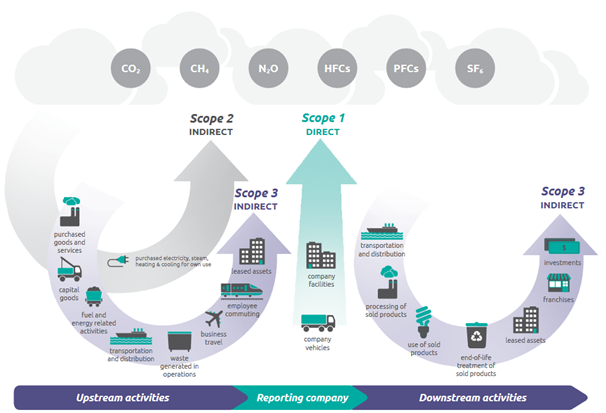The science is clear – greenhouse gas emissions in the atmosphere are warming the planet and in turn causing an alarming and destructive trend in weather events. Organizations of all kinds, particularly businesses, are being called on to calculate their own greenhouse gas emissions and take steps to eliminate them.
What are Greenhouse Gas Emission Scopes?
Greenhouse gas emissions include carbon dioxide, nitrous oxide, methane and four groups of fluorinated gases (sulfur hexafluoride, hydrofluorocarbons, perfluorocarbons, and nitrogen trifluoride). The Greenhouse Gas Protocol, a partnership between the World Resources Institute and the Business Council for Sustainable Development, categorizes greenhouse gas emissions into three Scopes:
- Scope 1: Directly generated emissions resulting from the consumption of fuels in operations, transportation and fugitive emissions, such as accidental leaks. For example, a plant that burns natural gas onsite would include these emissions in its Scope 1 calculations.
- Scope 2: Indirectly generated emissions resulting from the use of purchased electricity, steam, heating or cooling. For example, a plant that uses electricity purchased from a nearby power plant that generates emissions would include these emissions as part of its Scope 2.
- Scope 3: All the other indirect emissions that result from a company’s activities across its value chain. For example, a company that sends wastewater to a treatment plant will need to account for the emissions associated with that wastewater treatment in its Scope 3 calculations.
Overview emission categories

Greenhouse gas emissions are reported as metric tons of carbon dioxide equivalents (CO2e), which is the metric tonnage of CO2 emissions with the same warming potential as a metric ton of another greenhouse gas. Carbon dioxide equivalents are critical in climate reporting because they underpin every major reporting framework, and companies ready to start or expand their climate reporting efforts must be prepared to calculate their emissions in all three Scopes.
Scope 1 and 2 – Easy to understand, straightforward to calculate
When calculating Scope 1 and 2 emissions, a company must measure all the fuel it has burned onsite (Scope 1) and the purchased electricity, steam, heating or cooling from an energy utility (Scope 2). For companies that haven’t started the journey of calculating Scope 1 and 2 emissions, the process begins with data collection and usually involves facilities, purchasing and procurement departments.
Scope 2 emissions are highly dependent on the percentage and type of renewables of the local and regional grids, which is reflected in the “emissions factor” for the grid. There are two main methods for calculating Scope 2 emissions – location and market-based. According to GHG Protocol, a location-based method reflects the average emissions intensity of grids on which energy consumption occurs. A market based method reflects emissions from the electricity that companies have purposefully chosen. It derives emission factors from actual contracts, such as any type of contract between two parties for the sale and purchase of energy and the embedded GHG emissions.
To dive deeper into this topic and see the wide range of emissions factors, visit the EPA’s Emissions & Generation Resource Integrated Database (eGRID).
Scope 3 – The catch-all bucket for “other emissions”
As Scope 3 emissions happen in large part outside a company’s purview, calculating them is far more challenging than calculating Scope 1 and 2 emissions. But given that Scope 3 emissions usually make up most of a company’s carbon footprint, calculating them is critical to reducing overall emissions in line with science.
Examples of Scope 3 emissions include emissions generated by:
- The manufacturing of goods purchased by the company
- The extraction of raw materials purchased by the company
- The operation of the company’s products during their life
- The disposal of the company’s products at the end of their life
- Third-party treatment of wastewater discharged by the company
- The transportation and treatment of landfill waste generated by the company
In total, there are 15 official categories of Scope 3 emissions (see infobox). These categories include both upstream and downstream links in the value chain.
The 15 Categories of Scope 3 Emissions
Upstream Emissions:
• Purchased goods and services
• Capital goods
• Fuel- and energy-related activities (not included in Scope 1 and 2)
• Upstream transportation and distribution
• Waste generated in operations
• Business travel
• Employee commuting
• Upstream leased assets
Downstream emissions:
• Downstream transportation and distribution
• Processing of sold products
• Use of sold products
• End-of-life treatment of sold products
• Downstream leased assets
• Franchises
• Investments
Source: https://ghgprotocol.org/sites/default/files/standards/Scope3_Calculation_Guidance_0.pdf, pages 7 and 8
Strategies for calculating Scope 3
The process of calculating emissions generated in these 15 categories can be daunting. It often starts with a rough approximation of calculations for each of the 15 categories to get a broad picture, followed by drilling down into the most important categories using certain avenues to track down Scope 3 emission data.
There are multiple approaches for calculating Scope 3 emissions. The optimal approach is to base calculations on actual usage data, which normally can be determined from invoices and purchase orders. If this paper trail does not exist, a secondary approach is to conduct surveys to obtain direct and 4 indirect energy usage. If neither of the first two are options, estimations can be conducted to fulfill the calculations.
Locating data for calculating Scope 3 emissions
Paper trail data. For all the members of a value chain, we can inspect invoices and other documents that include the activity data needed to calculate Scope 3. For example, in the business travel category, flight records will yield miles flown, which can be converted to emissions.
Survey data. When the paper trails have been exhausted, surveys can gather useful data. For example, in the employee commuting category, we can survey employees to get data on the number of miles they commute annually and their transportation methods.
Estimates. When documentation is unavailable and querying the source is not feasible, companies can turn to the use of generally accepted equations and third-party vendors.
How Sustainserv can help
We help companies in a wide range of industries in the calculation of Scope 1, 2 and 3 emissions. Whether your company is just beginning, has mastered Scope 1 and 2 emissions but needs assistance with Scope 3, or is looking for support to manage an existing program, Sustainserv has the expertise to add value to your process.




